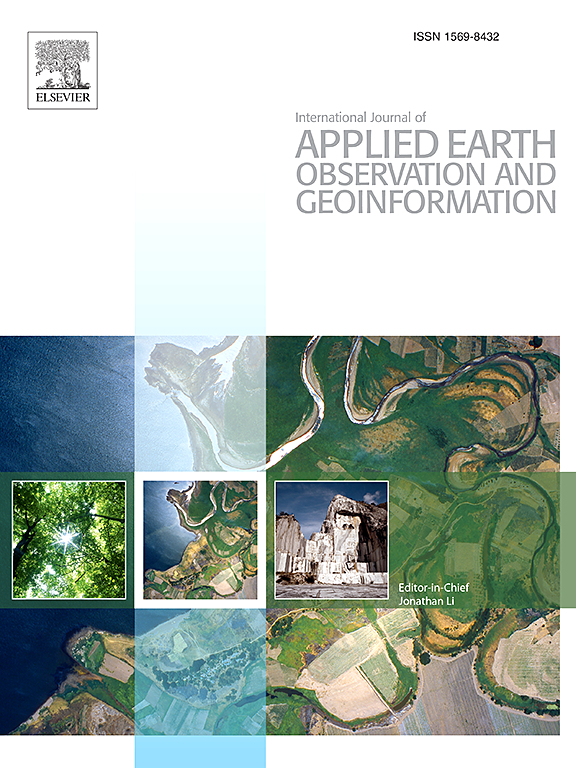Leveraging moisture elimination and hybrid deep learning models for soil organic carbon mapping with multi-modal remote sensing data
IF 7.6
Q1 REMOTE SENSING
International journal of applied earth observation and geoinformation : ITC journal
Pub Date : 2025-04-15
DOI:10.1016/j.jag.2025.104513
引用次数: 0
Abstract
Precision management of soil organic carbon (SOC) is crucial for regulating the global carbon cycle and ensuring food security. Currently, SOC prediction remains challenging due to unresolved moisture disturbances, underutilized multimodal remote sensing data, and uncertain model transferability. To address these challenges, a new paradigm integrating moisture elimination with advanced hybrid deep learning has been developed. Firstly, this research employs optimal cluster analysis based on soil moisture spatial characteristics, followed by the application of the Kubelka-Munk radiative transfer model to construct a moisture elimination strategy (MES). Next, a hybrid deep learning model, Multimodal Transformer Mechanism-Convolutional Neural Network-Convolutional Long Short-Term Memory (MT-CNN-ConvLSTM, MCCL), is constructed to enhance predictive accuracy and generalizability. The MCCL model was compared to other machine learning and deep learning models, including LSTM, Random Forest (RF), CNN, Artificial Neural Network (ANN), Support Vector Machine (SVM) and partial least squares regression (PLSR). Results indicate that (1) the proposed paradigm achieves optimal SOC content prediction accuracy in humid regions, with a root mean square error (RMSE) of 3.58 g kg−1, a coefficient of determination (R2) of 0.76, a ratio of performance to interquartile distance (RPIQ) of 2.26, and a mean absolute error (MAE) of 4.73 g kg−1. The model shows better performance in semi-humid regions, yielding an RMSE of 3.12 g kg−1, R2 of 0.77, RPIQ of 2.27, and MAE of 4.71 g kg−1, indicating significant spatial transferability. (2) Under MES, multiple models showed improved R2 using PLSR as the baseline: e.g., MCCL (41.4 %), LSTM (28.3 %), RF (17.2 %), CNN (14.1 %), ANN (8.1 %), and SVM (7.1 %). (3) The MES approach reduces RMSE by 1.06 g kg−1 and MAE by 1.58 g kg−1, while increasing R2 by 18.75 %, and RPIQ by 0.82. Using the KM radiative transfer model without cluster partitioning decreases RMSE and MAE by 0.58 g kg−1 and 0.23 g kg−1, while increasing R2 and RPIQ by 7.1 % and 0.3, respectively. Specifying the soil moisture gradient in the spectral correction process is crucial. The novel MES-MCCL paradigm proposed in this study is robust and provides promising insights into soil moisture masking’s spectral characterization and the potential of multimodal remote sensing for SOC monitoring.
利用水分消除和混合深度学习模型与多模态遥感数据进行土壤有机碳制图
土壤有机碳(SOC)的精准管理对于调控全球碳循环和保障粮食安全至关重要。目前,由于未解决的水分干扰、未充分利用的多模态遥感数据和不确定的模型可移植性,有机碳预测仍然具有挑战性。为了应对这些挑战,一种将消除水分与先进的混合深度学习相结合的新模式已经被开发出来。首先,采用基于土壤水分空间特征的最优聚类分析,然后应用Kubelka-Munk辐射传输模型构建消湿策略(MES)。其次,构建了多模态变压器机制-卷积神经网络-卷积长短期记忆(MT-CNN-ConvLSTM, MCCL)混合深度学习模型,以提高预测精度和泛化能力。将MCCL模型与LSTM、随机森林(Random Forest, RF)、CNN、人工神经网络(Artificial Neural Network, ANN)、支持向量机(Support Vector machine, SVM)和偏最小二乘回归(PLSR)等机器学习和深度学习模型进行比较。结果表明:(1)所提出的模式在湿润地区具有最佳的土壤有机碳含量预测精度,均方根误差(RMSE)为3.58 g kg - 1,决定系数(R2)为0.76,性能与四分位间距(RPIQ)之比为2.26,平均绝对误差(MAE)为4.73 g kg - 1。该模型在半湿润地区表现较好,RMSE为3.12 g kg - 1, R2为0.77,RPIQ为2.27,MAE为4.71 g kg - 1,表明该模型具有显著的空间可转移性。(2)在MES下,以PLSR为基准,MCCL(41.4%)、LSTM(28.3%)、RF(17.2%)、CNN(14.1%)、ANN(8.1%)和SVM(7.1%)等多个模型的R2均有改善。(3) MES方法使RMSE降低1.06 g kg - 1, MAE降低1.58 g kg - 1, R2提高18.75%,RPIQ提高0.82。采用无聚类划分的KM辐射传输模型,RMSE和MAE分别降低了0.58 g kg - 1和0.23 g kg - 1, R2和RPIQ分别提高了7.1%和0.3。在光谱校正过程中,确定土壤湿度梯度至关重要。本研究提出的新型MES-MCCL模式是稳健的,并为土壤水分掩蔽的光谱表征和多模态遥感对土壤有机碳监测的潜力提供了有希望的见解。
本文章由计算机程序翻译,如有差异,请以英文原文为准。
求助全文
约1分钟内获得全文
求助全文
来源期刊

International journal of applied earth observation and geoinformation : ITC journal
Global and Planetary Change, Management, Monitoring, Policy and Law, Earth-Surface Processes, Computers in Earth Sciences
CiteScore
12.00
自引率
0.00%
发文量
0
审稿时长
77 days
期刊介绍:
The International Journal of Applied Earth Observation and Geoinformation publishes original papers that utilize earth observation data for natural resource and environmental inventory and management. These data primarily originate from remote sensing platforms, including satellites and aircraft, supplemented by surface and subsurface measurements. Addressing natural resources such as forests, agricultural land, soils, and water, as well as environmental concerns like biodiversity, land degradation, and hazards, the journal explores conceptual and data-driven approaches. It covers geoinformation themes like capturing, databasing, visualization, interpretation, data quality, and spatial uncertainty.
 求助内容:
求助内容: 应助结果提醒方式:
应助结果提醒方式:


